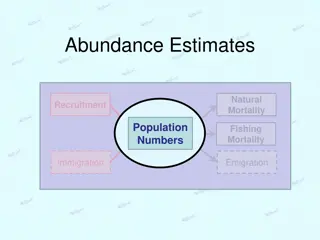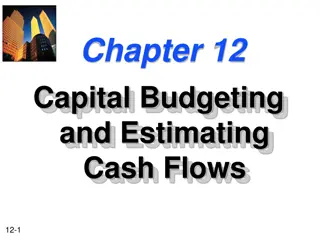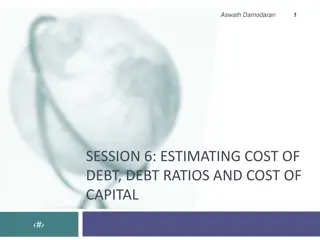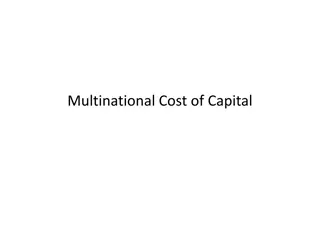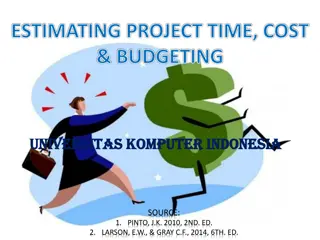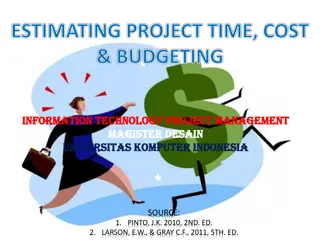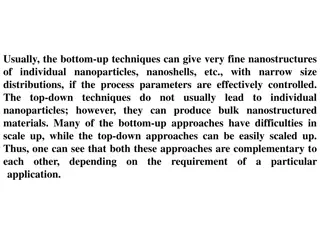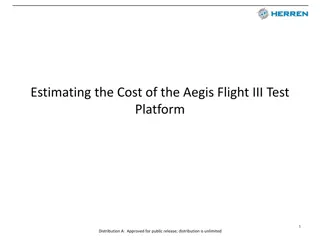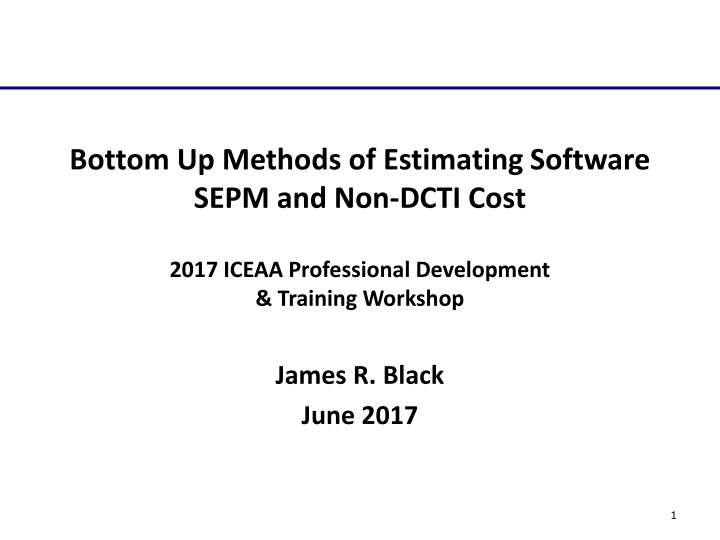
Bottom-Up Methods of Estimating Software SEPM and Non-DCTI Cost
Bio Presenter: James Jay Black, a software project manager, shares bottom-up methods for estimating SEPM and Non-DCTI costs in software development. Includes references and abstract on cost estimating basics using a Work Breakdown Structure.
Download Presentation

Please find below an Image/Link to download the presentation.
The content on the website is provided AS IS for your information and personal use only. It may not be sold, licensed, or shared on other websites without obtaining consent from the author. If you encounter any issues during the download, it is possible that the publisher has removed the file from their server.
You are allowed to download the files provided on this website for personal or commercial use, subject to the condition that they are used lawfully. All files are the property of their respective owners.
The content on the website is provided AS IS for your information and personal use only. It may not be sold, licensed, or shared on other websites without obtaining consent from the author.
E N D
Presentation Transcript
Bottom Up Methods of Estimating Software SEPM and Non-DCTI Cost 2017 ICEAA Professional Development & Training Workshop James R. Black June 2017 1
Bio Presenter: James Jay Black has 13 years of cost estimating experience and currently works as a software project manager for the Administration for Children and Families within the U.S. Department of Health and Human Services. In this role, he supports the Grants Center of Excellence software suite used to administer 1200 grant programs in eight Federal departments. Jay has a Masters in Systems Engineering from Johns Hopkins University and holds a current CCE/A certification. Jay worked for the Navy cost community (NAVAIR 4.2, NCCA, & NAVSEA 05C) from 2003 through 2015 For questions, comments, and/or feedback please email me at: James.robert.black@gmail.com James.black@acf.hhs.gov If any material in this brief is of use to you now or later, please email me, I d love to know 2
References & Abstract References/Acknowledgements: Mike Popp s observations on IEEE Standard 11207 Tim Lawless observations on Systems Engineering/Program Management Cost Estimating Body of Knowledge (CEBoK) Module 1 Cost Estimating Basics Presentation abstract: Systems Engineering/Program Management (SE/PM) and additional non- Design, Code, Test, and Integration (Non-DCTI) activities performed during software development efforts are often significant and drive estimates of total project costs Yet, cost estimates often omit the detailed research and analysis needed to adequately model SE/PM & Non-DCTI costs This brief will present bottom up methods useful for understanding and estimating these costs and share analysis of recent SE/PM & Non-DCTI data This presentation is the result of practicing detailed actual cost data collection for a variety of platform and system estimates/analyses 3
WBS is the Foundation Per Cost Estimating Body of Knowledge (CEBoK) Module 1 Cost Est. Basics: A Work Breakdown Structure (WBS) establishes a common frame of reference for relating job tasks to each other and relating project costs at the summary level of detail It provides a consistent and visible framework for specifying the objectives, labor, materials, and contracts of the system/program. The structure is used to define the total program/system by providing detailed definitions of individual elements required (via a WBS Dictionary) A WBS should be tailored for each system or program for the purpose of capturing all the idiosyncrasies endemic to each system/program Estimate uses a WBS that is at a level of detail appropriate to ensure that cost elements are neither omitted nor double-counted Estimate is presented in a WBS fully traceable to the system specification WBS structure is aligned to organizational structure performing the work; WBS element tasks are traceable to data, which is traceable back to the respective source documents The WBS is the foundation and a common WBS speeds the uptake of information for the cost estimate s audience 4
WBS Example - MIL-STD-881C For Department of Defense projects, WBS templates are provided in: MIL-STD-881C Work Breakdown Structures for Defense Material Items An example WBS from MIL-STD-881C for an Automated Information System follows: 1.0Automated Information System (AIS) 1.1AIS Prime Mission Product (PMP) Release/Increment X 1.1.1Custom Application Software 1 n 1.1.2Enterprise Service Element 1 n 1.1.3Enterprise Information System 1 n 1.1.4External System Interface Development 1 n 1.1.5AIS Platform Hardware 1.1.6System Level Integration 1.2System Engineering 1.3Program Management 1.4Change Management 1.5System Test and Evaluation 1.6Training 1.7Data 1.8Peculiar Support Equipment 1.9Common Support Equipment 1.10Operational/Site Activation 1.11Industrial Facilities 1.12Initial Spares and Repair Parts Design, Code, Test, & Integration (DCTI) Element-level software development Non-recurring, variable costs: driven by a software sizing measure, e.g. Source Lines of Code (SLOC) * SE/PM or SEPM System-level activities related to software, hardware, and integration Recurring, fixed costs: driven by a Level-of- Effort headcount mostly independent of software size So, what does it mean when estimators refer to Non-DCTI ? 5 * Note: 1.2 & 1.3 also include system level integration efforts
Software Cost Estimating Key Words Design, Code, Test, & Integration (DCTI) Systems Engineering & Program Management (SEPM) Non-DCTI - In the presenter s experience, Non-DCTI is the SEPM related to software development Exists as a recurring development activity Often begins before the start of non-recurring development activities (i.e. DCTI) Continues throughout the execution of DCTI activities Keep in mind: since Non-DCTI is not immediately identifiable in MIL-STD-881C, it can mean different things to different people When estimating software costs: be diligent in identifying how effort is allocated to DCTI, Non-DCTI and/or SEPM 6
IEEE Standard 12207 Systems and Software Engineering - Software Life Cycle Processes Fixed Costs SEPM System-level activities related to software, hardware, and integration DCTI Element-level software development IEEE 12207 is useful when differentiating between SEPM & DCTI 7 IEEE = Institute of Electrical and Electronics Engineers
Non-DCTI Estimating When estimating Non-DCTI: For continued development on an existing system (e.g. future spiral or increment): collect SEPM FTE actuals from prior spirals/increments (e.g. from CCDRs 1921 & 1921-1) For a new system: collect SEPM FTE actuals for analogous systems (e.g. from CCDRs 1921 & 1921-1) Normalize collected data: Identify how representative prior FTEs are of future effort required Parse total FTEs to identify software efforts Estimate Non-DCTI costs: First, use a bottom up estimating methodology: FTEs/year * Years of development * Labor Rate Then, use a crosscheck: DCTI cost or hours * Non-DCTI factor Primary estimating approach: bottom up methodology Crosscheck: factor driven approach 8 FTE = Full-Time Equivalent
SEPM as a Fixed Cost Why not use a parametric technique to estimate Non-DCTI? I.e.: why not use Excel s Analysis ToolPak or ACEIT Costat to develop a correlation between Non-DCTI Hours (or cost) and an objective measure (ESLOC, DSLOC, weight, volume, etc.)? SEPM is a predominately fixed and recurring cost: SEPM does not scale directly with the project s objective measures E.g.: for every additional ESLOC of a project, there is not a proportional increase in the number of SEPM FTEs Often varies significantly depending on the project/contractor/vendor However, SEPM does scale with the total number of concurrent baselines under development: E.g.: if the system under development will be integrated onto 2 different host aircraft types; then, the total SEPM costs will be greater than if the system was integrated onto 1 host aircraft type I.e.: costs for integrating a system onto 2 platforms > 1 platform Because SEPM is a predominately fixed & recurring cost, estimating it best served by a bottom up methodology 9
Collecting SEPM Actuals by Labor Category When collecting SEPM FTE actuals from contractors/vendors: Identify FTEs by constituent labor categories E.g. a small software development effort could be: FTEs Labor Category Project Manager System Architect Business Architect Software Development Lead Business Specialist Security Specialist Business Analyst Database Administrator Software Developer Quality Assurance Lead Test Engineer Technical Writer Total SEPM 1 0.5 0.5 0.25 1 0.25 1 DCTI SEPM, 6, 30% 1 DCTI, 14, 70% 1 1.5 8 0.5 2 0.5 1 6 10 14
Software Development Cost Rosetta Stone Software Development Cost = Variable Costs + Fixed Costs Fixed, Variable, Non Recurring Costs = (ESLOC * Growth) / Productivity * Labor Rate Recurring Costs = FTEs/year * Years of development * Labor Rate Software Development Cost Element Structure: Non-DCTI Design, Code, Test, & Integration (DCTI) (a.k.a. software SEPM) System-level Activities: System Requirements Analysis, System Architecture Analysis, System Integration, System Qualification Testing, Software Installation, & Software Acceptance Support Analog in IEEE/EIA 12207: Element-level Activities: Software Requirements Analysis, Software Architecture Analysis, Detailed Design, Code & Unit Test, Software Integration, Software Qualification Testing, Part of System Integration, & Process Implementation Analog in MIL-STD 881C: Inc. in Systems Engineering Program Management (SEPM) Prime Mission Product (PMP) Analog in CSDRs: Scope Captured in CCDR (1921 & 1921-1 forms) Scope Captured in SRDR (2630 forms) Analog in Production Estimating: SEPM Support-to-Touch Touch Labor 11 Slide POC: james.robert.black@gmail.com
Recommendations Get as much visibility as possible when collecting SEPM FTE actuals from contractors/vendors: Separately identify recurring and non-recurring FTEs Separately identify FTEs performing software, hardware, and integration related activities Identify FTEs by constituent labor categories (i.e. how many project managers, systems architects, business analysts, domain specialists or subject matter experts, etc.) If there are multiple concurrent spirals/increments or baselines, identify how the total SEPM is split between them Partition a software cost estimate into two components: Variable, non-recurring costs - DCTI, i.e. costs dependent on software size Fixed, recurring costs Software SEPM or Non-DCTI , i.e. costs independent of software size Visibility & Partitioning are useful when comparing cost estimates and briefing results to senior leaders 12
Summary The WBS is the foundation and a common WBS speeds the uptake of information for the cost estimate s audience When estimating software costs: be diligent in identifying how effort is allocated to DCTI, Non-DCTI and/or SEPM IEEE 12207 is useful when differentiating between SEPM & DCTI Because SEPM is a predominately fixed & recurring cost, estimating it best served by a bottom up methodology Factor driven estimating methodologies are useful in the absence of time/data and can be useful crosschecks 13
Backup 14
SEPM Scaling with # of Platforms Example where a second host platform is added in Year 4 of development: SEPM does scale with the total number of concurrent baselines under development: E.g.: if the system under development will be integrated onto 2 different host platform types; then, the total SEPM costs will be greater than if the system was integrated onto 1 host platform type I.e.: costs for integrating a system onto 2 platforms > 1 platform 120 FTEs 100 80 2x DCTI FTEs 60 Add'l SEPM for second platform Non-DCTI FTEs 120 40 1x 100 20 Baseline SEPM for primary host plaform 80 0 Year 1 Year 2 Year 3 DCTI FTEs Year 4 Year 5 60 Non-DCTI FTEs SEPM is a predominately fixed cost, but does scale with the # of platform types 20 40 15 0 Year 1 Year 2 Year 3 Year 4 Year 5
IEEE Standard 12207 5.3 The Development Process Activity Tasks (paraphrased) 5.3.1 Process Implementation .2 Document and control outputs .3 Select and use standards, tools, languages .4 Document development plans .5 Deliver all needed products 5.3.2 System requirements analysis 5.3.3 System architectural design 5.3.4 Software requirements analysis .3 Conduct joint reviews iaw 6.6 5.3.5 Software architectural design .3 Document top-level design for database .4 Document preliminary user documentation .5 Document preliminary test requirements .6 Evaluate architecture against criteria .7 Conduct joint reviews iaw 6.6 5.3.6 Software detailed design .2 Document design for interfaces .3 Document design for database .4 Update user documentation .5 Document unit test requirements .6 Update integration test requirements .7 Evaluate detailed design against criteria .8 Conduct joint reviews iaw 6.6 5.3.7 Software coding and testing .3 Update user documentation .4 Update integration test requirements .5 Evaluate code and test results 5.3.8 Software integration .2 Conduct and document integration tests .3 Update user documentation .4 Document qualification tests .5 Evaluate plans and tests against criteria .6 conduct joint reviews iaw 6.6 5.3.9 Software qualification testing .3 Evaluate tests against criteria .4 Support audits iaw 6.7 .5 Prepare product for next phase 5.3.10 System integration .2 Document integration tests .3 Evaluate integrated system against criteria 5.3.11 System qualification testing .3 Support audits iaw 6.7 .4 Prepare product for installation 5.3.12 Software installation .2 Install software iaw plan 5.3.13 Software acceptance support .3 Provide training per contract DCTI Element-level software development 12207.1 Information Item guidelines -- -- -- Plan, Desc -- -- Specification Spec, Record 6.26 SRS, 6.6 SRER .1 Define software life cycle model -- -- -- 6.5 DPP, 6.17 SDSD .1 Specify system requirements .2 Evaluate requirements against criteria 6.26 SRS SEPM System-level activities related to software, hardware, and integration .1 Establish top-level architecture .2 Evaluate architecture against criteria Description Desc, Record 6.25 SARAD 6.25 SARAD, 6.6 SAER .1 Document software requirements .2 Evaluate requirements against criteria Desc Desc, Record -- Description Description Description Description Plan Desc, Record -- Description Description Description Description Plan Plan Rec, Desc -- Desc, Rec, Proc Report Description Plan Rec, Plan Plan, Proc Report Description Proc Proc, Desc Record, Plan Report Description Record -- Record Report Procedure Record Report Record -- Record -- -- Report Record -- 6.22 SRD, 6.30 UDD 6.22 SRD, 6.6 SRER -- 6.12 SAD 6.19 SIDD 6.4 DBDD 6.30 UDD 6.27 T/VP 6.12 SAD, 6.6 SAER -- 6.16 SDD 6.19 SIDD 6.4 DBDD 6.30 UDD 6.27T/VP 6.27T/VP 6.6 DDER, 6.16 SDD -- 6.4 DBDD, 6.24 SCR, 6.28 T/VPr 6.29 T/VRR 6.30 UDD 6.27T/VP 6.7 EOCR,6.6 SCTRE, 6.24SCR, 6.27T/VP 6.18 SIP, 6.28 T/VPr 6.29 T/VRR 6.30 UDD 6.28 T/VPr 6.28 T/VPr, 6.30 UDD 6.6 SIER, 6.18 SIP 6.29 T/VRR 6.30 UDD 6.6 SIER -- 6.24 SCR 6.29 T/VRR 6.28 T/VPr 6.6 SQTER 6.29 T/VRR 6.6 SER -- 6.24 SCR -- -- 6.29 T/VRR 6.24 SCR -- .1 Transform requirements into architecture .2 Document top-level design for interfaces .1 Document design for each component DCTI Element-level software development .1 Document each unit, database and tests .2 Conduct and document unit testing .1 Document integration plans .1 Conduct and document qualification testing .2 Update user documentation SEPM System-level activities related to software, hardware, and integration .1 Integrate software with hardware & others .1 Conduct and document qualification tests .2 Evaluate system against criteria .1 Plan installation in target environment .1 Support acquirer's acceptance tests .2 Deliver product per contract 16



